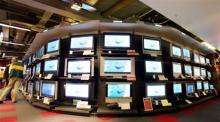Diode lights offer bright future for low energy

German scientists said Wednesday they had tweaked organic light-emitting diodes (OLEDs) -- the materials used in flat-screen TVs, laptop computer screens and mobile phone displays -- to become flexible, energy-efficient sources of white light.
Sebastian Reineke and colleagues of Dresden's Technical University, reporting in the British journal Nature, modified the internal structure of a white-light OLED to reduce internal energy loss and boost photon output.
The improved device yielded 90 lumens (a measurement of brightness) per watt of electricity consumed, he told AFP.
This compared to 15 lumens for a conventional incandescent light bulb and between 50 and 70 lumens per watt for modern compact fluorescent light bulbs.
Reineke said OLED screens could be used to light a room or provide a reading light, provided they overcame two obstacles in order to make the product commercially feasible.
The first is to boosting the lifespan of important components called "blue emitters" and also achieve economies of scale in manufacturing, he said.
(c) 2009 AFP
















